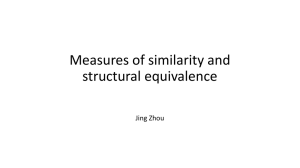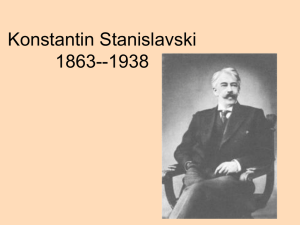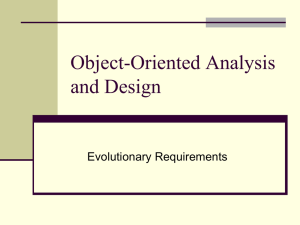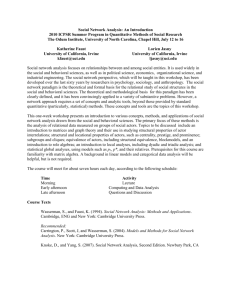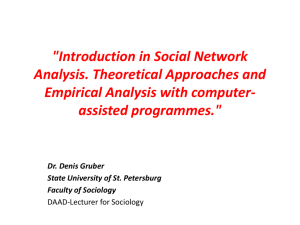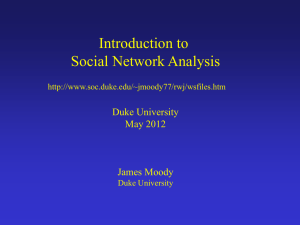CH2
advertisement
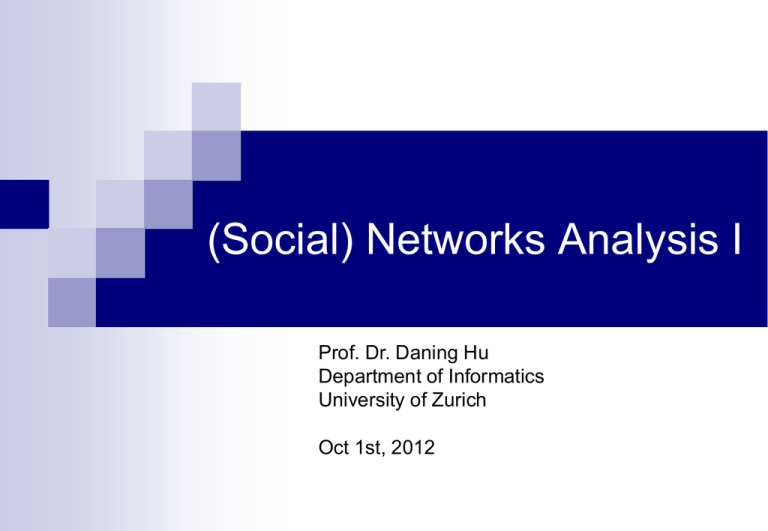
(Social) Networks Analysis I Prof. Dr. Daning Hu Department of Informatics University of Zurich Oct 1st, 2012 Outline Basic Concepts of Networks Two Modes of Social Network Analysis Network Data Modeling and Analysis (For Tutorial) Ref Book: Social Network Analysis: Methods and Applications (Structural Analysis in the Social Sciences) http://www.amazon.com/Social-Network-Analysis-ApplicationsStructural/dp/0521387078 2 What is a Network? Node: Any entity in a network (person, system, group, organization) Tie/Link: Relationship or interaction between two nodes. Fundamental Concepts in (Social) Network Analysis Node, Actor (Social Network) Tie, Link Dyad and Triad Subgroup and Group Node and Actor “Discrete individual, corporate, or collective social units” (Wasserman/Faust 2008:17) Node Example: Products in a purchase newtork, Computers in the Internet. Actor Examples: people in a group, departments within in a corporation, public service agency in a city, nation-states in the world system “Node” does not imply that they have intention or the ability to “act” Tie and Link Actors (nodes) are linked to another by social ties (links) Example of direct ties in SNA (Wasserman/Faust 2008:17): Evaluation of one person by another (expressed friendship, linking, or respect) Transfers of material resources (business transactions, lending or borrowing things) Behavioral interaction (talking together, sending messages) Physical connection (a road, river, or bridge connecting two points) Biological relationships (kinship or descent) Indirect ties Association or affiliation (jointly attending a social event, or belonging to the same social club) Undirected vs Directed Ties 7 Strength of Ties or Links 8 Dyad and Triad Dyad: a tie between two actors “consists of a pair of actors and the (possible) tie(s) between them” (Wasserman/Faust 2008:18) Shows “properties of pairwise relationships, such as whether ties are reciprocated or not, or whether specific types of multiple relationships tend to occur together” Triad: “Triples of actors and associated ties” (Wasserman/Faust 2008:19) “a subset of three actors and the (possible) tie(s) among them” (Wasserman/Faust 2008:19) Triadic analyses focus on the fact whether the triad is Transitive : if actor i “likes” actor j, and actor j in turn “likes” actor k, then actor i will also “like” actor k Balanced: if actors i and j like each other, then i and j should be similar in their evaluation of a third actor, k, and i and j dislike each other, then they should differ in their evaluation of third actor, k Group and Subgroup Group “is the collection of all actors on which ties are to be measured” (Wasserman/Faust 2008:19) Subgroup of actors is defined “as any subset of actors, and all ties among them” (Wasserman/Faust 2008:19) Actors in a group “belong together in a more or less bounded set (…) consists of a finite set of individuals on which network measurements are made” (Wasserman/Faust 2008:19) “however, in research applications we are usually forced to look at finite collections of actors and ties between them.” (Wasserman/Faust 2008:20) Two Modes of Social Network Analysis One-mode complete network 12 One-mode ego network 13 Ego Network Analysis Ego Network Analysis combine the perspective of network analysis with the data of mainstream social science No computer assisted analysis needed 14 Two-mode Complete Network 15 Two-mode Ego Network 16 Two-mode Network Transformation From Zan Huang et al., 2009 17 Network Analysis: Data Modeling and Analysis 18 Network Distance Matrix 19 Network Analysis: Major Data Formats 20 Example of Real-World Networks Protein network Freshwater food web The Internet The World-Wide Web High school friendship network 21 22 What do we want to find out through network analysis? How to model the topology of large-scale networks? What are the organizing principles underlying their topology? How does the topology of a network affect the diffusion of information, innovation, fads, contagious diseases, and viruses in a network? How do networks evolve? 23 What differences exist between a social network analysis and a non-network explanation? In non-network explanations the main focus is on: attributes of autonomous individual units, the associations among these attributes, and the usefulness of one or more attributes for predicting the level of another attribute social network analysis: refers to the set of actors and the ties among them views on characteristics of the social units arising out of structural or relational processes or focuses on properties of the relational system themselves the task is to understand properties of the social (economic or political) structural environment, and how these structural properties influence observed characteristics and associations among characteristics relational ties among actors are primary and attributes of actors are secondary (Wasserman/Faust 2008: 6-9)



